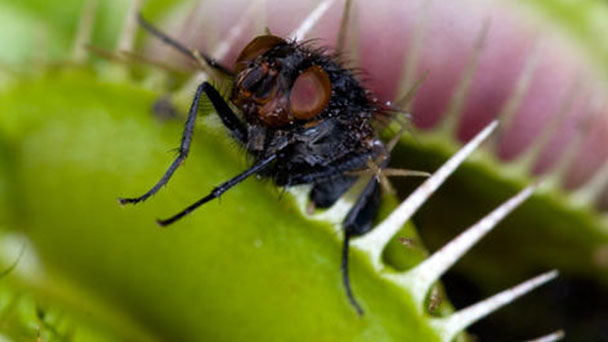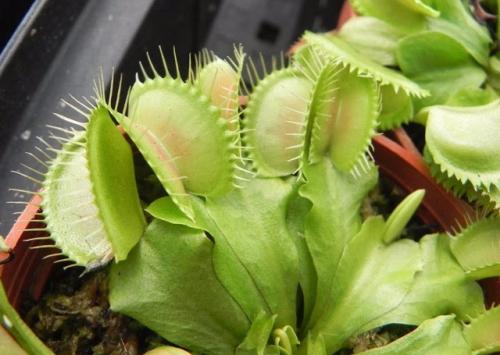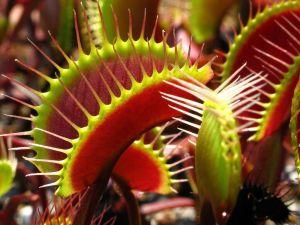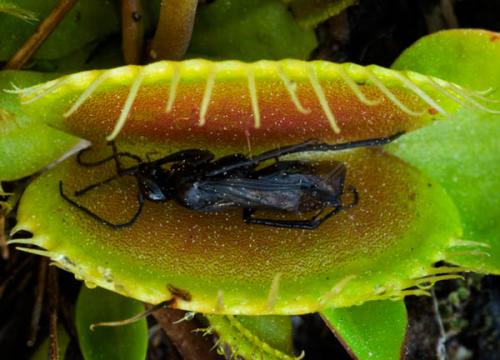How to Grow and Care for Venus Flytrap (Dionaea Muscipula)
Written by Maggie
Jan 11 2023

Growing Venus flytrap needs to seed soaking time about 2 days to clean water. After the red jade soil ground flowerpot and placed in the above water moss, the seed evenly onto the prepared matrix, then it can be placed in the soft light maintenance. Do not regularly during the period of hydrating, normal maintenance of 1 ~ 2 weeks can sprout. The following are steps to grow Venus flytrap and Venus flytrap care.

Description of the Venus Fly Trap
A carnivorous deciduous perennial plant is the Venus Fly Trap. The plant has light green leaves. The trap is green or dark red inside the leaf's hinge. To complete the trap, the leaves have side projections that resemble filaments. The plant's leaves are low-set and 2 to 5 inches long. The plant's remaining portions are all green.
On stalks that are between four and twelve inches long, white cupped Venus Fly Trap flowers bloom in May and June. This prevents pollinators from becoming dinner by keeping the flowers above the traps. The plant produces a black fruit with seeds in June and July.
What to Feed a Venus Flytrap
Their main food source is flies or other small insects, as suggested by their name. The catch is that the prey must be alive when it is caught. Venus flytraps can't feed on dead flies because the insect needs to move around inside the trap in order for it to close and start digesting the food. For the trap to close tightly around it and keep out bacteria, it must also be small enough.
- Read More: How Does A Venus Flytrap Kills & Eat Insect
The simplest Venus flytrap feeding technique is to release tiny flies into a closed terrarium where plants are being grown. The bugs will eventually be drawn to the traps and caught there, where they will be eaten. Although carnivorous, flytraps can go for extended periods of time (a month or more) without eating insects. They will receive enough food on their own if you grow them outside. Venus flytraps need to be fed bugs on occasion if they are being grown indoors. It may be challenging to feed your flytrap live flies, but small spiders, beetles, and caterpillars will also work. Avoid giving it any insects that are bigger than a third of the size of the trap.
- Read More: How Big Do Venus Flytrap Get
Steps to Grow Venus Flytrap
1. Soak in Water
Venus flytrap plant is currently one of the more hot plants, mainly feeding on insects, so Venus flytrap is kind, Venus flytrap before planting the seeds takes the emergence. When growing Venus flytrap, wee can use clear water soaking seeds after 2 days can be removed to grow, and Venus flytrap seeds have only 3 months shelf life, and cannot be stored for a long time.
2. Water Moss Planting
Water moss is the best culture substrate for Venus Flytrap. Water moss should be soaked with water before it can be used. Terracotta soil with strong moisturizing ability should be added to the basin bottom.
3. Venus Flytrap Care After Growing
After the seeds are planted, they should be placed in a light environment and receive more than 4 hours of light every day. If the seeds are conserved by hydroponics, they should be replenished with water in time during the rooting period, and the growth temperature should be maintained at about 20℃. After 1 to 2 weeks of normal conservation, they can germinate. (Read More: How to Grow Venus Flytraps from Seed)
4. Transplant Seedlings
Venus Flytrap plants can be transplanted when they grow about 2-3 leaves. Venus Flytrap has strict requirements on water quality. Ordinary tap water is rich in mineral elements and contains a high amount of alkali, so it is not suitable for daily cultivation of Venus Flytrap.

How Often Should I Repot a Venus Flytrap Plant?
To avoid fungus and rotting problems, Venus flytraps should be repotted every one to two years. The plant's needs are no longer being met by the growing medium as it deteriorates. A new, larger pot will be required if the flytrap has significantly grown. If it hasn't expanded much, you can simply replace the old medium with new potting soil and re-use the pot you already have. As will be covered below, repotting is a great opportunity to divide the plant.
- Also Read: How to Repot a Venus Flytrap
Growing Venus Flytrap Care
Venus Flytrap is cultivated with more than 5 hours of sunlight a day, temperature controlled at about 25℃, slightly acidic soil, peat and perperite, water once a day, fertilizer from the edge of the container or spray fertilizer on its surface, fertilizer is applied about half a month. Don't feed it or touch it when you grow and care for Venus flytrap. The following are growing Venus flytrap care.
Light and Temperature
The Venus Flytrap needs full light to grow. It can be placed in direct sunlight all year round, no less than five hours a day, but it needs to be shaded at noon in the summer. In terms of temperature, it is best to control the temperature at about 25℃, and the temperature can not be lower than 6℃ in winter.
Soil
When we grow and care for Venus flytrap, it is best to choose slightly acidic soil, with pH around 4.0. Instead of growing Venus Flytrap with ordinary garden soil or soil, you can use a 2:1 mixture of peat and perlite to make the soil. If possible, you can also grow Venus Flytrap with imported water moss as the substrate.
Watering
Venus Flytrap likes moisture, you can water Venus Flytrap once a day when watering, watering thoroughly, keep the basin soil moist, it is best to choose pure water when watering. When we grow and care for Venus flytrap, we can also place a water tray at the bottom of the Venus Flytrap at a height of about 1.5 centimeters, which will keep the Venus Flytrap moist at all times. Don't place a water tray if the air is humid.
- Read More: How Often Should You Water a Venus Flytrap
Fertilizing
When fertilizing Venus Flytrap, be careful not to fertilize its roots, as that will cause its roots to rot. You can either pour fertilizer from the edge of the container to keep it away from its roots, or dilute it and spray it on its surface. Use the Venus Flytrap fertilizer and apply it once every half a month or so.
Don't Feed Too Much
When growing and caring for Venus Flytrap, many people like to feed it various insects or other meat products, which will lead to indigestion of Venus Flytrap. Venus Flytrap itself can catch food, so it only needs to fertilize Venus Flytrap in normal times to ensure its healthy growth. (Read More: Are Venus Fly Traps Producers)
Don't Touch
Do not touch Venus Flytrap when you grow and care for it. Many people will put their fingers into the trap out of curiosity. Although Venus Flytrap is non-toxic, doing so will cause the burr on the trap and leave blood holes on the hand, so do not touch Venus Flytrap easily.

How Do I Grow a Venus Fly Trap as a Houseplant?
A healthy fly trap needs to be repotted as soon as possible to ensure its proper care. These carnivorous plants require a saucer and a 4-5 inch pot with drainage holes. Get a tall pot because Venus Fly Traps develop long roots.
Venus Fly Trap Care in the Winter
Venus fly traps require a period of dormancy to survive. The plant will appear to be dead because its leaves will turn black and drop off. It is only resting, not actually dead. During the winter, keep your Venus flytrap in a dimly lit area that is cool, at or below 40F (4C). Around three months must pass during the dormancy period.
During this time, the plant should be damp but not wet in order to prevent root rot. It requires some light while dormant. Use a light sulfur dusting on the plant if you are using a basement or garage to prevent fungus from developing there. Make frequent checks to ensure that the plant is free of fungus. Fungus is typically a sign of excessive humidity. Manual mold removal, repotting, or exposure to bright light can all be used to treat the plant and restore its moisture balance.
Slowly warm up the flytrap and expose it to more light following the 3–4 month dormant period. It will become damaged if you expose it right away to heat and sunlight.
Early Spring Care
Your plants will gradually emerge from dormancy as the temperature slowly climbs and the daylight hours lengthen. Cut off all of the old leaves to make room for flower buds and new leaf growth. Later in the spring, look for flowers.
Venus Fly Trap Care: Indoors Vs. Outdoors
When grown outdoors as a winter-tender plant as opposed to indoors, venus fly traps require far less maintenance. Unless you have a very sunny windowsill and can give the plants a lot of attention, home environments aren't ideal. In this article, I'll cover both indoor and outdoor Venus fly trap care, though, as I am aware that not everyone has the means or space to grow them outdoors.
The Best Planting Mix for Venus Flytrap Plants
Whether you choose to grow your fly trap outdoors or indoors, you must first decide which growing medium to use. In bogs' extremely sparse, deficient-in-nutrient soil, Venus fly traps have developed. They therefore evolved the fascinating adaptation of relying on nutrients taken up from their insect prey rather than those found in the soil.
Planting Venus fly traps in potting soil or garden soil is not recommended. Use a mixture instead that is made up of two parts peat moss and one part perlite. A 50/50 mixture of peat moss and perlite is an alternative mixture. Another choice is to use pure, high-quality sphagnum moss.
Do Venus Flytraps Need to Be in a Terrarium?
In an aquarium or terrarium, many people attempt to grow Venus fly traps. Because the temperature rises too high for the plants, this typically causes plant death. The plant has a slim chance of surviving. The terrarium's top is left off to maintain a low enough temperature for the plants, and the glass walls keep the humidity that the plants require inside.
Common Problems & How to Fix
Look out for the following signs that your Venus flytrap isn't happy with its current conditions:
Brown and Crispy Leaves
Allowing the plant to become overly dry can result in browning, crispy leaves, and broken traps because Venus flytraps require consistently moist soil and high humidity. Consider putting your plant next to a humidifier and make sure to keep it consistently slightly moist (but not soggy).
Skipped Dormant Period
Humans need time to unwind and recharge, and Venus flytraps need this too. Your plant should enter dormancy as the days grow shorter and the temperature drops. It is best to let your plant follow its natural rhythm rather than trying to "keep it awake" over the winter. Venus flytraps naturally go dormant during the winter. If you follow the aforementioned care instructions, your plant should reach dormancy on its own.
Black Spots
It's probably a problem with the growing medium if you notice black spots or unpleasant odors on your plant. For this particular plant to thrive, the soil must be devoid of minerals and nutrients. Your plant will be poisoned by any other kind of soil.
Frequently Asked Questions
Is It Illegal to Grow a Venus Fly Trap?
Possessing a Venus fly trap is not against the law. It is forbidden to take one from the wild or purchase one from someone who has. In their natural habitat, venus fly traps are in danger, and poachers are a major issue. Purchase the new Venus fly trap from reputable nurseries or growers who propagated it from more established, cultivated flytraps. (Also Read: How Much Does Venus Flytrap Cost)
Can a Venus Flytrap Hurt Me?
A Venus flytrap isn't strong enough to "bite" you with any power. The plant will probably suffer more harm than you if you stick your finger inside of it. (Also Read: How Does the Venus Flytrap Work?)
Does Venus Flytrap Have Any Predators?
Aphids and spider mites can harm the plant indoors. Outside, raccoons, birds, and squirrels have all been known to munch on them.
Latest Updated
- Benefits of Bugleweed - 7 Science-backed Health Benefits
- Bugleweed Dangers & Side Effects - Is It Poisonous?
- How to Plant Evergreen Trees - What You Should Know
- When to Plant Evergreens - Grow Guide for Evergreen Trees
- 12 Wonderful Evergreen Shrubs for Your Garden
- 12 Popular Evergreen Plants with Pictures for Beginners
- When And How To Prune A Lilac Bush Like a Pro
- How to Grow & Care for Lilac Vine (Hardenbergia Violacea)
- Japanese Lilac Tree (Syringa Reticulata) Care & Propagation Guide
- Shumard Oak Pros and Cons - What to Know
Popular Articles
- Winter maintenance of Antirrhinum Majus
- How to Grow Terminalia Mantaly Tree
- How to Grow and Care for Crossostephium Chinense
- How to grow Antirrhinum Majus in spring
- Peristeria Elata (Dove Orchid) Profile: Info & Care Guide
- Underwatered Snake Plant (Sansevieria Trifasciata) - Signs And How To Fix
- How to Care for Brazilian Jasmine Plant (Mandevilla Sanderi)
- How to Grow & Care for Graptopetalum Purple Delight in Summer
- Rosa Chinensis (China Rose): Plant Growing & Care Tips
- How to Care for Baby Sun Rose (Aptenia Cordifolia)